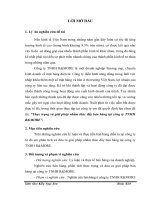More sedimentary rocks
Bạn đang xem bản rút gọn của tài liệu. Xem và tải ngay bản đầy đủ của tài liệu tại đây (7.08 MB, 37 trang )
Today’s Lecture:
Types of sedimentary
rocks
Chapter 7: Sedimentary Rocks
Concepts of textural &
mineralogical maturity
Nature and classification
of detrital sedimentary
rocks
Turning sediments into
sedimentary rocks.
Stratification features
of sedimentary rocks
◆ Detrital (or “clastic”)
Sedimentary Rocks
❖ Made up of fragments (clasts) of pre-existing rocks.
❖ In terms of composition, the most mature contain:
- Clay minerals (weathering of feldspar)
- Quartz (resistant to weathering)
❖ Presence of unstable minerals (mafics, feldspars)
indicates immaturity:
- limited weathering
- rapid transport and deposition near source
❖ For detrital rocks, particle (clast) size:
- most basic distinguishing factor for naming
rocks.
Sedimentary rock classification
is based on texture and composition.
Rock type
Main criterion
Detrital
◆ Particle size
Chemical
◆ Mineral composition
Classification of
detrital (or “clastic”)
sedimentary rocks
Based on size of clasts (particles):
Sediment name
❖ Gravel
Size
larger than 2 mm
(1/10 inch)
❖ Sand
sand-sized
❖ Silt, Mud, Clay very fine-grained
Rock name
Conglomerate
or Breccia
Sandstone
Shale or Mudstone
Decrease in grain size with increasing transport
Inferring Depositional Processes
Sedimentary rocks contain many clues
about the processes that formed them.
Clast Size
Current
Velocity
Transport
Distance
Proximity to
Source
◆ Large clasts
Stronger
Shorter
Deposited
Nearby
◆ Small clasts
Weaker
Composition
of clasts:
Longer
Deposited
Far Away
Tell us about the nature of
the source rocks.
Loose Sediments
gravel
sand
silt
clay
Sedimentary
rocks
conglomerate
sandstone
siltstone
shale
Detrital Sedimentary
Rocks
❖ Other important textural features:
Grain shape (Roundness, sphericity)
angular
intermediate
rounded
Angular
Well-rounded
Shapes of sand grains
Detrital Sedimentary
Rocks
❖ Other Important Textural Properties:
Grain size sorting
Range of particle sizes in a sediment or rock
Very poorly-sorted
moderately sorted
Very well-sorted
Fig. 7.18
Upstream, nearer the
source, clasts are
larger& more angular
(texturally immature).
They also contain a
greater proportion
of unstable minerals
& rock fragments
(compositionally
Immature).
Fig. 7.29b
Fig. 7.28c
© Martin Miller
Products of long-term weathering and erosion:
Quartz and clay
Detrital Sedimentary
Rocks
Conglomerate
❖ Composed mostly of
pebble to boulder-sized clasts
❖ Clasts well-rounded.
(angular clasts form a
rock called “breccia”).
❖ Usually poorly-sorted.
❖ Deposited by high energy currents:
- flooding rivers
- streams near mountain source
areas (steep)
- mudlfows
Detrital Sedimentary
Rocks
Breccia
❖ Course like a conglomerate,
but with angular grains.
❖ Short transport!
❖Deposited close to the source
area for sediment.
◆
Detrital sedimentary
rocks
Sandstone
❖ Composed of sand grains
❖ 2nd most abundant sedimentary rock
❖ Deposited by moderately active transport processes:
- Running water (rivers & deltas)
- Along shorelines (beaches)
- By the wind (sand dunes)
❖ Mostly quartz (chemically stable), feldspar, micas, &
rock fragments.
Mineralogy of sands reflects their source
skeletal
Tahiti
quartz
Wisconsin
obsidian
Hawaii
reef carbonate
Australia
“Oolites”
Cancun, Mexico
skeletal
Oregon
Example:
Well-sorted
Poorly-sorted
◆
Detrital Sedimentary
Rocks
Shale & Siltstone
❖ Silt & clay-sized particles (mud, clay, silt)
❖ Over 1/2 of all sedimentary rocks.
❖ Particles too small to identify w/ naked eye.
❖ Deposited in quiet (slow moving) water.
- deep ocean & continental slope
- lakes
- floodplains of rivers
❖ Tends to form slopes when eroded.
❖ Raw material for making brick, tile, pottery, china.
Two minute in-class
exercise:
Name this rock and
describe the degree
of sorting.
Two minute in-class exercise.
Describe the grain sorting and rounding
of the quartz sand above. What does
it take to get a sediment like this?
Turning sediment into rock
Process of transforming unconsolidated
sediment into rock is called “lithification”.
How does this happen?
Sand to sandstone: How?









